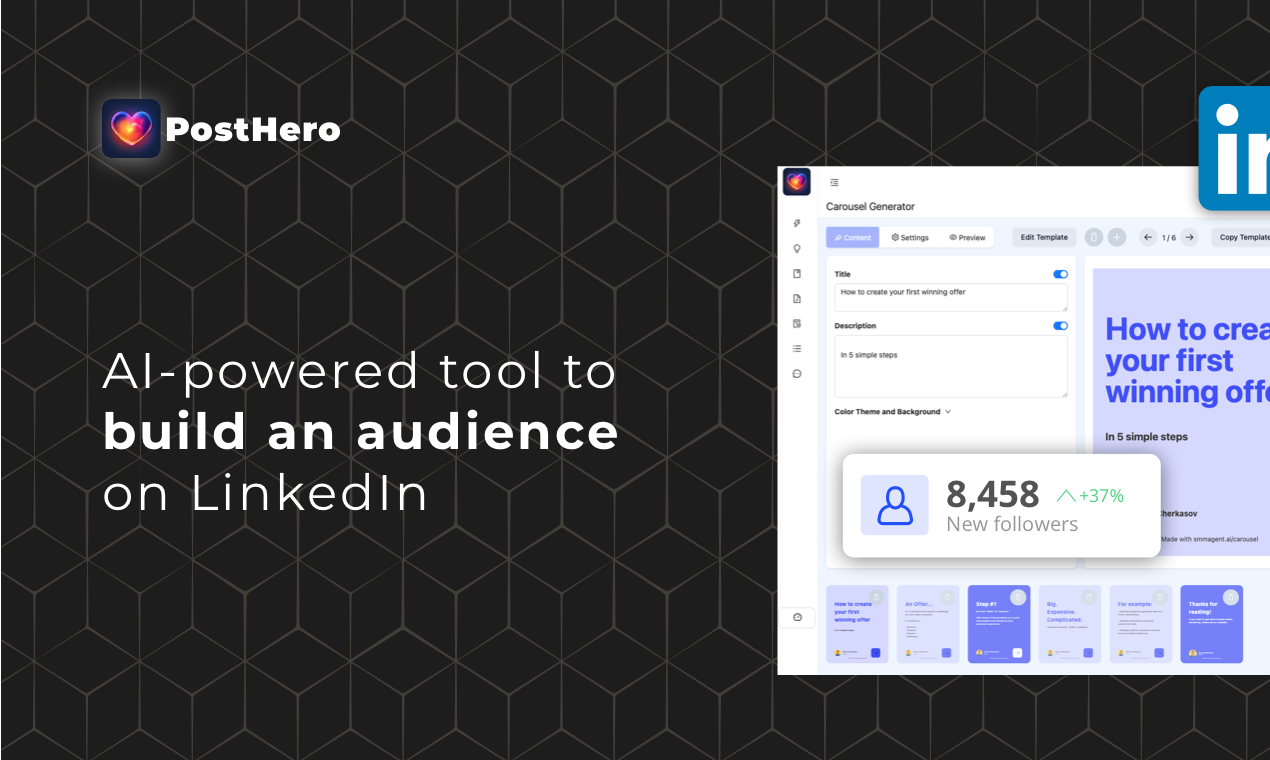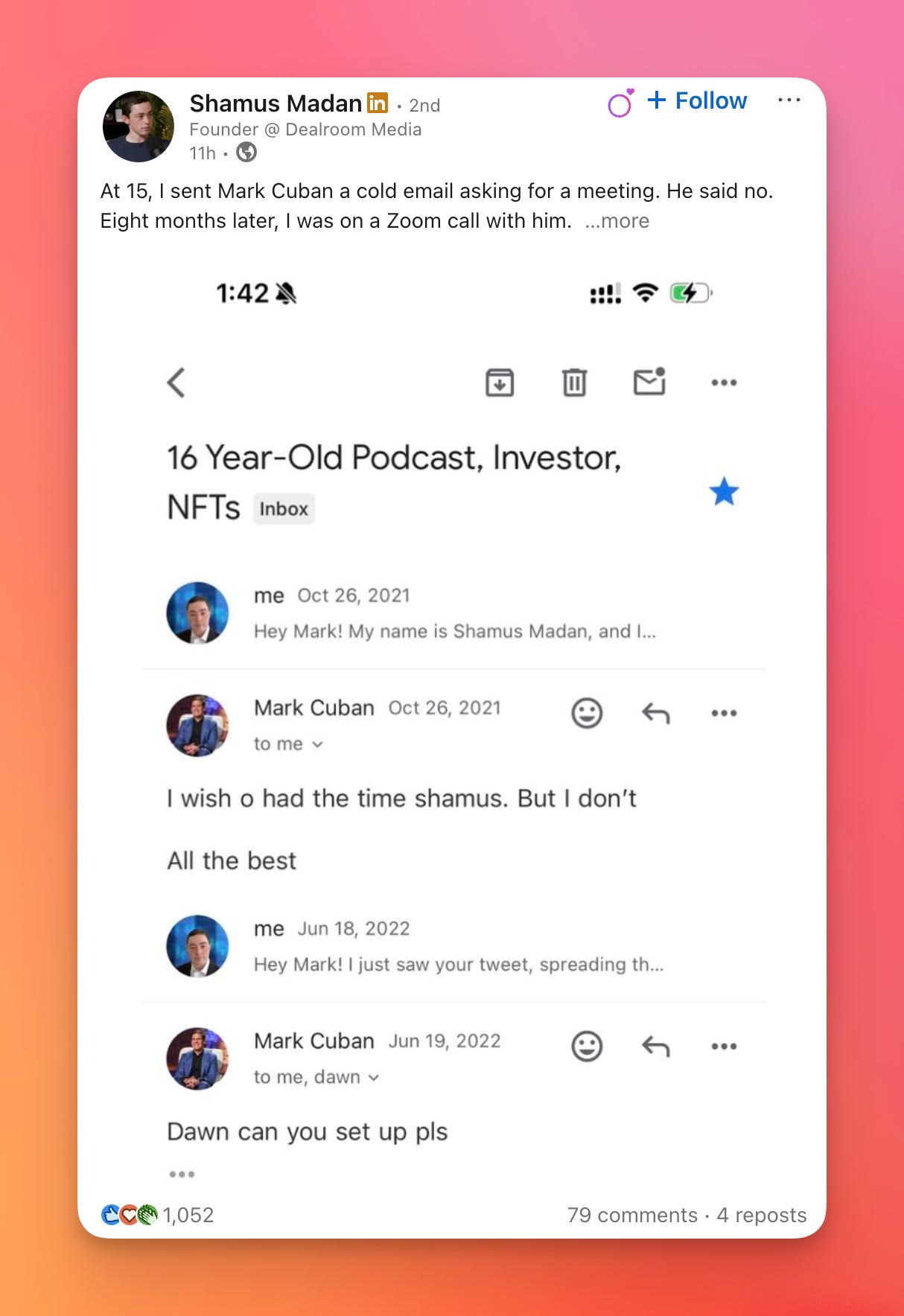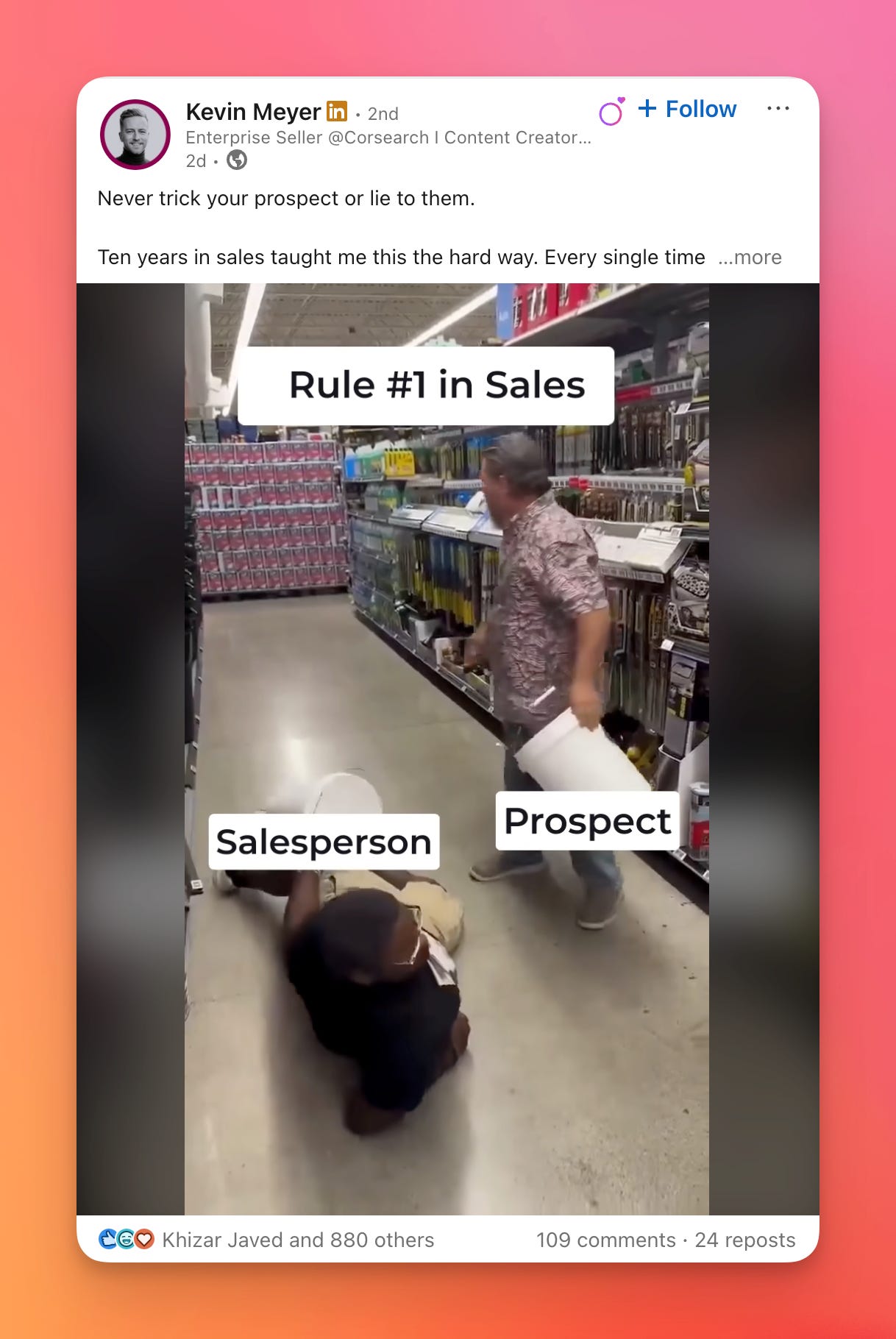LS #60: LinkedIn for Startups: Advanced Tactics for Seed Stage Startups
Most seed stage founders use LinkedIn like a megaphone. They blast company updates, share funding news, and wonder why their posts get 3 likes from their team and mom.
Hi there,
I break down top LinkedIn posts to help you craft content that resonates.
In this issue, you’ll find:
The 3 high-performing LinkedIn posts this week
LinkedIn for startups: advanced tactics for seed stage startups
The 3 high-performing posts this week
1. Sofia Vergara is worth $180M.
Why this post?
This post went viral, receiving almost 1.6k likes in a day. It received 5-35 more engagement and views than John’s posts this week.
WHY THIS POST WENT VIRAL
This post completely flipped people’s understanding of Sofia Vergara’s success story. Most people thought she got rich from Modern Family, but learning she built multiple businesses 15 years before the show blew their minds. The post also gave hope to people with accents or other perceived disadvantages by showing how Sofia turned what Hollywood saw as a weakness into her biggest strength. The specific business examples and timeline made it feel real rather than just motivational fluff.
BREAKDOWN
Shocking wealth hook: “Sofia Vergara is worth $180M“ - grabs attention with huge number
Counterintuitive twist: “But she built her empire before fame” - challenges what people think they know
Business foundation: “In 1994, while Hollywood was ignoring her accent” - sets up the underdog story. “Co-founded Latin World Entertainment“ - shows she was an entrepreneur first.
Key insight: “Fame is temporary. Equity is forever.” - memorable principle people can apply
HOW TO CREATE YOUR OWN POST:
Start with surprising wealth: Use a specific dollar amount that makes people stop scrolling
Challenge assumptions: Point out what everyone thinks vs. what actually happened
Correct misconceptions: Directly tell people what they got wrong about this person’s success
Include struggle elements: Show how they turned obstacles into advantages
End with empowerment: Help people see their perceived weaknesses as potential strengths
POST IDEAS FOLLOWING THIS TEMPLATE:
“Ryan Reynolds is worth $350M - but not from acting”
“The Rock made more from tequila than from movies last year”
“Jessica Alba’s business empire started in her kitchen”
“Gwyneth Paltrow’s Goop makes more than her entire acting career”
“Ashton Kutcher’s investments made him richer than Two and a Half Men”
TOGETHER WITH POSTHERO
Grow your audience faster on LinkedIn. With an AI-powered tool that helps you create content and grow on LinkedIn.
Create high-converting content that helps you grow on LinkedIn
Create a weekly content in 76 seconds
AI Voice assistant for creating content in seconds
2. At 15, I sent Mark Cuban a cold email asking for a meeting. He said no. Eight months later, I was on a Zoom call with him.
Why this post?
Another post that went viral this week—it got 1k likes in 11 hours and performed 5-12 times better than Shamus’s other posts this week.
WHY THIS POST WENT VIRAL
This post combined three powerful elements: a famous person (Mark Cuban), an incredible age story (15-year-old entrepreneur), and proof that persistence actually works. People love seeing young people succeed, especially when they get rejected first and then find a way to win. The email screenshot made it impossible to fake, and the specific strategy of shifting from asking for help to offering value gave people a clear takeaway they could use. The ending with $1M ARR proved this wasn’t just a lucky break but actually led to real business success.
BREAKDOWN:
Bold age claim: “At 15, I sent Mark Cuban a cold email” - immediately establishes youth and ambition
Initial rejection: “He said no” - sets up the disappointment everyone can relate to
Persistence payoff: “Eight months later, I was on a Zoom call with him” - shows the power of not giving up
Detailed story: Breaks down the 8-month journey of becoming “undeniable” through work
Strategic pivot: Explains how he shifted from asking for help to offering value
Specific opportunity: “Cost Plus Drugs“ mention shows he was paying attention to Mark’s interests
Massive result: “1.2 million views on LinkedIn alone” - proves the value he delivered
HOW TO CREATE YOUR OWN POST:
Start with impressive age: Mention how young/old you were when you took a big swing
Show the initial failure: Don’t pretend it worked immediately - rejection is relatable
Prove persistence paid off: Demonstrate that not giving up eventually worked
Include real evidence: Screenshots, emails, or photos that prove your story is true
Admit humble beginnings: Don’t pretend you were already successful when you started
Break down the work: Show what you did during the time between rejection and success
Explain the strategy shift: Reveal the moment you changed from asking to giving
3. Never trick your prospect or lie to them.
Why this post?
This post performed 2-8 times better than Kevin’s other posts this week.
WHY THIS POST WENT VIRAL
This post worked because it took a strong moral stance that most people agree with but many struggle to follow in practice. The falling buckets meme perfectly visualized how dishonest sales tactics crush the salesperson in the end, making the lesson memorable and shareable. People in sales could relate to seeing colleagues use shady tactics and watching them fail, while prospects appreciated seeing someone call out bad behavior they’ve experienced. The practical alternatives gave salespeople actual strategies to use instead of just telling them what not to do.
BREAKDOWN:
Strong moral stance: “Never trick your prospect or lie to them” - takes a clear ethical position
Experience credibility: “Ten years in sales taught me this the hard way” - shows he learned through mistakes
Perfect meme choice: Video showing salesperson pretending he’s also a victim - clever visual metaphor for dishonest sales tactics
Labels for clarity: “Salesperson“ and “Prospect“ make the metaphor obvious
Practical alternatives: Gives specific actions like “be upfront about limitations” and “admit when you don’t know”
Memorable ending: “Trust takes years to build and seconds to destroy” - quotable wisdom
HOW TO CREATE YOUR OWN POST:
Take a moral stand: Pick an unethical practice in your industry and argue against it
Share your learning curve: Admit you had to learn this lesson through making mistakes
Use relatable comedy videos: Funny scenarios where people pretend to be victims of the same tricks they’re pulling work well for showing sales hypocrisy
Provide actionable alternatives: Don’t just say what not to do - give people what to do instead
Connect ethics to results: Show how doing the right thing actually helps business outcomes
LinkedIn Guide
LinkedIn for Startups: Advanced Tactics for Seed Stage Startups
Most seed stage founders use LinkedIn like a megaphone.
They blast company updates, share funding news, and wonder why their posts get 3 likes from their team and mom.
Meanwhile, I just helped one seed stage founder generate 1,000+ qualified leads from LinkedIn in a single month using advanced tactics most startups never discover.
The difference? We stopped acting like a startup and started acting like a category creator.
The Seed Stage LinkedIn Reality
What most seed stage founders do wrong:
Post about features nobody understands yet
Focus on fundraising instead of problem-solving
Wait until they have “something to show” before posting
What actually works at seed stage:
Build category awareness for the problem you solve
Educate the market on why this problem matters now
Position yourself as the expert who saw this coming
Create demand for your MVP
The truth: At seed stage, your biggest competitor isn’t another startup. It’s the status quo.
Advanced Tactic #1: The Problem Pioneer Strategy
Why Traditional Startup Content Fails:
Most founders post about their solution when their market doesn’t even know the problem exists yet.
Example of solution-focused content: “Excited to announce our AI-powered customer success platform that automates retention workflows using predictive analytics!”
Why it fails:
Sounds like every other AI startup
Doesn’t explain why this matters
Assumes people know they have the problem
No emotional connection to the pain
The Problem Pioneer Approach:
Position yourself as the person who identified an emerging problem before others noticed.
The Problem Pioneer Framework:
Step 1: Identify the underlying shift creating your problem
Step 2: Share data/trends showing this shift
Step 3: Connect the dots to business impact
Step 4: Hint at why existing solutions don’t work
Example of problem pioneer content: “Why 67% of SaaS companies will have a customer success crisis by 2026…”
Why this works:
Establishes you as someone who sees trends early
Creates urgency around a problem they might not have noticed
Positions traditional solutions as inadequate
Attracts people experiencing these exact issues
Advanced Tactic #2: The Market Education Campaign
The Challenge at Seed Stage:
Your ideal customers don’t know they need your category of solution yet.
Traditional approach: “Here’s our product and why it’s better” Advanced approach: “Here’s why this entire category of problems matters”
The 90-Day Market Education Strategy:
Month 1: Problem Awareness
Share industry data showing the emerging problem
Post about companies struggling with this issue
Interview customers about their pain points
Create content around “the hidden cost of [problem]”
Month 2: Solution Category Education
Explain different approaches to solving this problem
Compare traditional methods vs new approaches
Share case studies of companies trying different solutions
Position your approach as one of several options
Month 3: Thought Leadership
Predict where this problem/solution category is heading
Share your unique methodology or framework
Discuss what the future looks like when this problem is solved
Establish yourself as the category expert
Example Month 1 post: “The hidden cost of customer complexity:
Talked to 50 SaaS founders last month. Here’s what I learned…”
Advanced Tactic #3: The Ecosystem Network Strategy
Why Traditional Networking Fails for Seed Stage:
Most founders network with other founders who can’t buy from them or help them raise money.
Better approach: Build relationships with the ecosystem around your customers.
The Ecosystem Mapping Framework:
Tier 1: Direct Ecosystem
Industry analysts and researchers
Consultants who work with your ideal customers
VCs who invest in your space
Journalists who cover your industry
Tier 2: Adjacent Ecosystem
Founders solving related problems
Tool makers your customers also use
Industry event organizers
Podcast hosts in your space
Tier 3: Influence Ecosystem
Thought leaders your customers follow
Authors who write about your problem space
Speakers at industry conferences
LinkedIn creators with your audience
The Ecosystem Engagement Strategy:
For Tier 1 (High Priority):
Comment thoughtfully on every post
Share their content with your insights added
Offer to provide data/insights for their research
Invite them to exclusive startup events
For Tier 2 (Medium Priority):
Engage regularly with their content
Offer collaboration opportunities
Make valuable introductions
Partner on content creation
For Tier 3 (Consistency Priority):
Like and share their relevant content
Add valuable comments when you have insights
Tag them in relevant discussions
Reference their work in your content
Example ecosystem engagement: “[Analyst Name] just published excellent research on customer success trends. The data point about a 40% increase in support tickets particularly resonated - we’re seeing the exact same pattern in our customer interviews.
Adding to [Analyst’s] point: The companies handling this best seem to be those who’ve moved from reactive support to predictive guidance.
Worth a read for anyone in customer success: [link]”
Advanced Tactic #4: The Founder-Market-Fit Narrative
Why Generic Founder Stories Don’t Work:
Everyone shares the same “why I started this company” story focused on personal motivation.
Better approach: Tell the story of why you’re uniquely positioned to solve this specific problem at this specific moment.
The Founder-Market-Fit Story Framework:
Element 1: The Unique Insight What did you see that others missed? What trend did you spot early?
Element 2: The Personal Experience How did you personally experience this problem? What gave you insider knowledge?
Element 3: The Market Timing Why is now the right time for this solution? What changed recently?
Element 4: The Unique Approach What’s your differentiated view on how to solve this?
Advanced Tactic #5: The Customer Development Content Strategy
Turn Customer Discovery into Content Gold:
Traditional approach: Do customer interviews privately Advanced approach: Share insights from customer research publicly (with permission)
The Customer Development Content Framework:
Weekly Interview Insights: “Talked to 5 [ideal customers] this week about [problem]. Here’s what I learned...”
Monthly Pattern Recognition: “After 20 customer interviews, seeing clear patterns emerge...”
Quarterly Trend Analysis: “3 months of customer research revealed something interesting about [industry]...”
Example customer development content: “Interviewed 12 SaaS customer success leaders this week. Here are the patterns…”
Seed Stage LinkedIn Metrics That Matter
Vanity metrics (ignore these):
Total followers
Post likes
Profile views
Market building metrics (track these):
Engagement from ideal customers
Inbound messages from qualified prospects
Speaking/podcast opportunities
Industry recognition and mentions
Business metrics (optimize for these):
Qualified leads from LinkedIn
Customer acquisition from content
Talent attraction and hiring
Investor interest and meetings
The Seed Stage LinkedIn Success Formula
Problem Pioneer Positioning (identify emerging problems first) + Market Education (teach the category, not just your product) + Ecosystem Networking (connect with the broader value chain) + Founder-Market-Fit Story (why you, why now) = Category leadership before competition arrives
At seed stage, you’re not just building a product. You’re building a market.
That’s a wrap for today.
See you next week! If you want more LinkedIn tips, be sure to follow me on LinkedIn (link).
If you love this episode and want to support us, spread the word about us by sharing The LinkedIn Secrets with colleagues. I really appreciate it!
Thank you for reading!
What’d you think of today’s edition?
Help me to understand what you think about this episode. Just reply with a number (1, 2, or 3) to this email.
1 - Damn good
2 - Meh, do better
3 - You didn’t cook it
Your compadre,
Anton “LinkedIn growth strategies” Cherkasov





